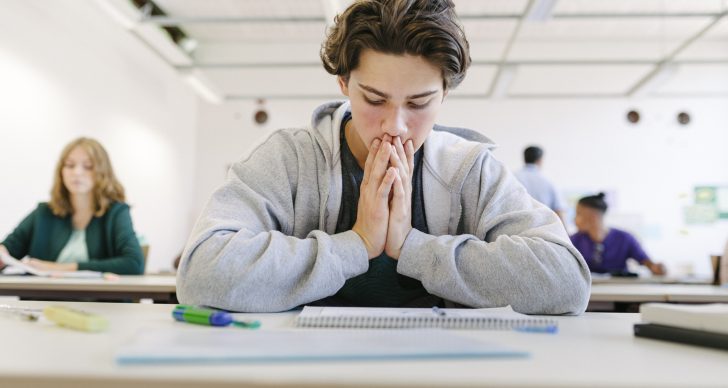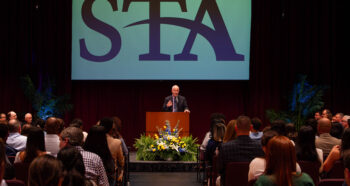“Exams.” Even the word itself can evoke stress and anxiety! There is often so much myth and mystery surrounding exams that they can seem to have a life of their own. It is true that taking exams can be stressful – you are being asked to recall, analyze and synthesize, all within a time limit. But it is also true that there are some very practical things that we can do to help manage ourselves in stressful situations.
We’ve been helping schools develop student wellbeing for over 10 years, since founding our consultancy MindWell Education. In this blog, we share some techniques to help students manage their stress during exams, and to help teachers support them.
Understanding our mind
• Have you ever been in a test situation and just ‘drawn a blank’? You’ve studied, but once in the exam room you seem to have forgotten everything and can’t think straight?
This is not your fault! When we are in stressful situations, sometimes our executive functioning can go ‘offline.’ This is because the stress centre of our brain has taken over – this is the part that instinctively pushes us to fight, flee or freeze. Drawing a blank can often be an indicator that you are in ‘freeze’ mode. The part of your brain that is used for strategising and organising is not fully available to you at this moment.
• Our own storytelling minds can sometimes contribute to our stress. Our brains don’t like uncertainty and are designed to ‘fill in the blanks’ to make sense of situations. Worried thinking can make mountains out of molehills. But just having worried thoughts about something doesn’t make it true. Quite often things we spend a lot of time and energy worrying about turn out to not be as bad as we had imagined. Whenever we notice the storytelling mind is spiraling off (again!) into mountain making, we can learn to let go of those circular thoughts by grounding ourselves in our physical, present moment experience.
How can we actually calm our minds?
This knowledge of how our brains and bodies react to stress is helpful so we can have some intellectual understanding of how we function on a physiological as well as psychological level. We can also develop a more experiential understanding by using simple, practical exercises that we can practice when we are calm in order to be able to apply them during stressful times.
Stress activates our sympathetic nervous system, but we can help our minds get back ‘online’ by activating our parasympathetic nervous system with simple exercises. For example:
• Connecting back in with the body, bringing our attention to our feet, seat or hands can be helpful (see Feet Seat Hands practice at the end of this blog)
• Working with the breath to calm our system (see Hot Chocolate Breath at the end of this blog)
These are a couple of examples of mindful awareness practices which can be very helpful for managing stress and anxiety. A good regular preventative practice is to help ground ourselves in our body, learning to calm our physical, mental and emotional systems. We can spend so much time ‘in our heads’ worrying about the future – like the exam that is coming up! – that it can be very helpful to bring our attention back to the body, intentionally experiencing sensations that we find there. This can help us unhook from the worrying mind.
These tips and strategies are not only helpful for exams, they are also transferable to other stressful areas of our lives. There is no magic solution to alleviating all our stress. What is helpful though, is the recognition that there are some things that we can do to help manage it.
A message for teachers
It can be very useful to incorporate some of these strategies into the exam itself. This can be a simple reminder to students to take a moment before starting (and if possible, between tasks), taking a few deeper breaths or using any practices they’ve already learned to help them ground themselves before they begin.
Prior to the exam, the body will be primed with adrenaline – which can provide helpful energy – but it can also sometimes create disruption. A settling practice can help your students to not rush into answering that first question too quickly and help them focus more clearly. This is most useful when students have already had some mindful awareness training prior to the examination and when it is practised in mock exams first. Some schools invite students to consider a settling and grounding practice and even guide the students in a calming practice before entering the exam hall.
Research for school-based mindfulness research on adolescents is still in its early stages. However, here are two studies with promising results, especially for showing how these practices can go far beyond dealing with exam stress in helping support our students’ development of positive mental health and overall wellbeing:
• After an eight-week mindfulness training course students showed:
Better focus, less distraction.
Reduced self-critical thinking.
(Sanger and Dorjee, 2016)
• Mindfulness training helped students stay more resilient during challenging times (e.g., sitting exams). After training, compared with the control group, students had:
Fewer visits to the doctor due to mental health problems.
Improved empathy.
Maintained level of overall wellbeing.
(Sanger et al., 2018)
And of course, what we want for our children, we need for ourselves. Bringing these wellbeing skills effectively to young people very often rests on our experience of using them for our own stress management so we can effectively share them with others – enhancing wellbeing for all!
Example Practices
Note: Once you get a feel for these practices, they can be synthesized down to just a few moments of grounding or breathing.
Hot Chocolate Breath Practice (Burke & Hawkins, 2021:74)
Imagine you have a cup of hot chocolate, and it smells very good, but it is too hot to drink.
As you hold it in your hands you can breathe in through your nose to smell it, and then blow very gently on it to cool it down. Careful not to splash it!
Just try that a few times now. Breathe in through the nose and blow out gently through the mouth.
What did you notice?
What many people find with this type of breathing is that it calms their system down a little. You might not have noticed anything right now but try practicing this again sometime when you are already calm and see how it feels. Then you can use this breathing in moments when you are feeling anxious or upset.
Feet Seat Hands Practice (Burke & Hawkins, 2021: 62-63)
We have recorded this for you so you can experience it for yourself before guiding your students (www. mindwell-education.com/mtt-resources).
Sit in a way that feels both relaxed and alert. Connected with the chair and the floor and also with a sense of sitting well; an uplift through the spine; the hands relaxed on the desk or lap… Allowing your eyes to look gently onto the desk or floor, or, if you feel comfortable to, allowing the eyes to close.
And now bringing your attention, like a spotlight, down to your feet. Can you just feel the feet from the inside? The socks and shoes around the feet; the connection with the floor underneath…If it helps just wiggle the toes a little and then seeing if, when they are still, you can continue to notice any sensations.
And now lightly scanning that spotlight of attention up the lower legs, and the upper legs until you can focus on the connection with the chair beneath you. The pressure through your seat on the chair, being pulled down by gravity. What does that feel like right now?
And finally, from feet, to seat to hands. Wherever your hands are now, can you shine that spotlight of attention on them as you did with the feet? How do your hands feel? Can you sense the palms of the hands? … the backs of the hands? …
See if you can bring a kind curiosity to your experience; not worrying if you can’t really feel anything right now; just doing the best you can to point the spotlight of attention on the hands. Perhaps noticing the spaces between the fingers. Any sensation of heaviness or lightness. Of warmth or coolness. Any tingling or pulsing…
And now letting go of that focus on the Feet, Seat and Hands, and becoming aware of anything else that comes to your attention… Perhaps the breath coming and going… the sense of quiet or sounds around you…
If your eyes were closed just gently opening them, noticing how you feel, notice how the room feels. Perhaps stretching a little…
Note: Finger Press (Burke & Hawkins, 2021:168) and Ground Down (Burke & Hawkins, 2021:100-1) can also be useful before and during exams.
Please feel free to contact us at any time through www.mindwell-education.com if you have any questions!
This article was co-authored with Kevin Hawkins.
Kevin has worked with adolescents and young people in various contexts for over 30 years – as teacher, school head, and social worker in the UK, Africa, and Europe. He currently lives in Valencia, Spain and was previously in the Czech Republic where for 10 years he was Middle School Principal at the International School of Prague. In 2012 he co-founded MindWell, (mindwell-education.com) which supports educational communities around the world in developing Awareness-Based Wellbeing through mindfulness and social-emotional learning.
Kevin is a Senior Trainer for the Mindfulness in Schools Project (UK) and a facilitator of the evidence-based CARE program (Cultivating Awareness and Resilience in Education). He has also worked as a coach to school leaders and was lead consultant to the International Baccalaureate Organisation on SEL and mindfulness. Kevin is a regular speaker, writer and presenter on the topics of wellbeing, leadership, mindfulness and social-emotional learning in education. His first book, Mindful Teacher, Mindful School: Improving wellbeing in teaching and learning, was published by SAGE, in 2017. His second book, The Mindful Teacher’s Toolkit, written with Amy Burke for SAGE/Corwin is out now!
You can follow Kevin on Twitter @kevinjhawkins11.
Further resources
Discover more resources to support mental health and wellbeing from Cambridge.
Watch Amy and Kevin’s contribution to our Creating the Conditions for Success conference.
References
Burke, A. & Hawkins, K. (2021) The Mindful Teacher’s Toolkit: Awareness-based Wellbeing in Schools. London: SAGE.
Sanger, K. and Dorjee, D. (2016) ‘Mindfulness training with adolescents enhances metacognition and the inhibition of irrelevant stimuli’. Trends in Neuroscience and Education, 5(1): 1–11.
Sanger, K., Dorjee, D., and Thierry, G. (2018) ‘Effects of school-based mindfulness training on emotion processing and well-being in adolescents: Evidence from event-related potentials’. Developmental Science, 21(5): e12646. Available at: www.ncbi.nlm.nih.gov/pmc/articles/PMC6175003/ (accessed on 27/7/20).





